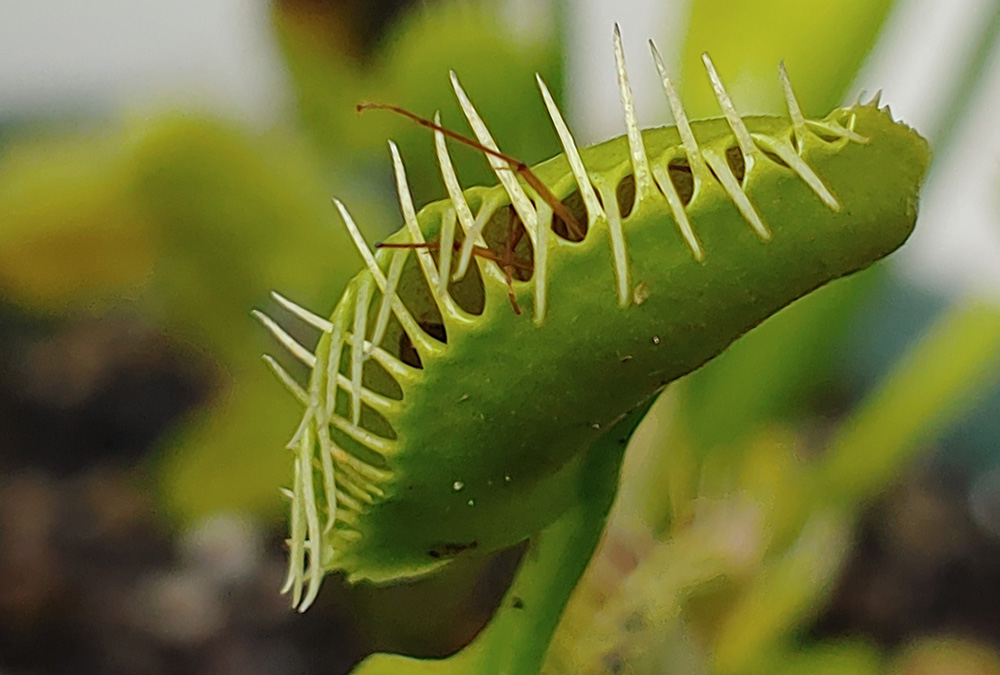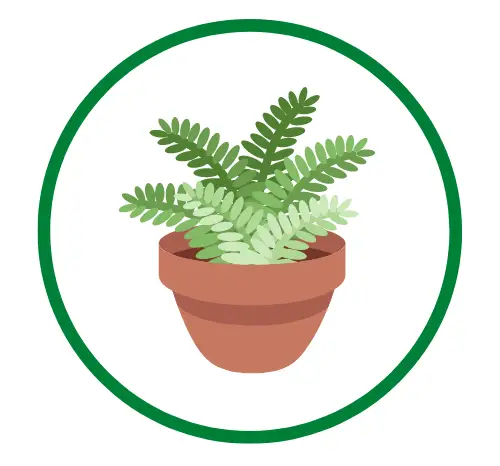
We, gardeners, love our plants, and we relish seeing (and fanning) the flames of plant passion burning in others. There comes a time in many kids’ lives when one particular plant sparks a powerful desire. Typically that plant is the infamous Venus flytrap. Venus flytraps are living proof that the world is full of expectation-defying possibilities. “Humble plant turns the tables on the animal kingdom” makes for a hot headline, like analog clickbait. The idea of growing your own little shop of horrors must satisfy something more universal than we care to admit.
If your inner child comes bursting out when passing by a carnivorous plant display, only to be followed by your inner parent repeating, “It’s just gonna die—it’s an exotic, picky plant,” I’m here to talk back. Venus flytraps are completely growable in the Southeast, and summer is the perfect time to indulge would-be savage gardeners, young and seasoned alike.

Don’t be fooled by its otherworldly name; the Venus flytrap is a native plant! In fact, it is native only to a small area of the U.S. Southeast—in wet pine savannas and bogs from the Green Swamp Preserve in North Carolina down into a bit of South Carolina. Ever walked around a swampy pine savanna? Such places hold all the clues to successfully growing flytraps and other native carnivorous plants, such as pitcher plants and sundews, Venus Flytrap. Good light, a peaty-sandy soil, and constant moisture at their roots are the keys to happy insect-trapping native flytraps.
How to grow venus flytrap from seeds?

- Harvest your flytrap seeds when the seedpods are ripe. This will usually occur in August through September, depending on your climate. If you purchase your seeds from a nursery, ask the nursery when the seeds were harvested. Ideally, you want seeds that are no more than a couple of months old. Viability declines significantly a couple of months after harvest. If they are more than a couple of months old, make sure the seeds were stored in refrigerators. Under refrigeration, flytrap seeds can last for years.
- Sprinkle evenly on a pot of soil. Use a soil mix of 50% peat moss and 50% perlite. Make sure the soil is completely moist. Use a 4-inch pot if you are sowing a small pinch of these seeds (about 25 seeds). Sprinkle your seeds evenly over the soil and very gently tap them down. It’s a lot easier to sow your seeds in one pot and separate them later after they germinate.
- Fungal and mold spores grow in damp conditions, the very conditions necessary to germinate your seeds. To prevent mold and fungus, spray your seeds with Neem oil or a sulfur-based fungicide. Throughout the germination period, watch for mold and fungus and treat accordingly.
- Keep your pot in standing water. Use a tray or a bowl to set your pot in, and fill it up with water. Keep the water line no more than halfway up the pot. Use low mineral water. Keep the temperature at 75° for optimal germination. (Unlike other US-native carnivorous plants, flytrap seeds do not require stratification.)
- Your seeds will germinate within four to eight weeks, depending on temperature. Look for tiny versions of the adult Venus Flytrap. As soon as you see signs of germination, make sure your seedlings are getting lots of bright sunlight. Place your seedlings on a brightly lit windowsill or grow them under strong fluorescent lights.
Within a few months, your Venus Flytrap may be up to 1/8-inch in diameter. After growing your flytraps indoors for their first winter, acclimate them to outdoor growing where they can receive full sun during spring and summer. Do this in May, after the last frost of the year.
Typically flytraps will be only 1/4 to 1/2 inch tall at the end of their first year. They will reach flowering maturity by their third season.
Healthy and unhealthy venus flytrap


Unhealthy venus flytrap
Steps to Success
1. Pick healthy plants. Your local garden center may carry carnivorous plants, but make sure they are being grown in decent light and with adequate moisture, and that they appear sturdy. If you have the option of examining their roots, look for half an inch of long white tips. The majority of each root is dark, but the light tip shows it is growing.
2. Choose the right container. Pick a container to fit the size of your plant. It must have drainage holes. A 3-to-4-inch-diameter container is appropriate for one flytrap. If you’re going all in and creating a mixed planting that includes pitcher plants, choose something that is at least 9 inches in diameter and more shallow than deep. If your container doesn’t come with a saucer, you can repurpose other trays that will hold a couple inches of water. Don’t be tempted to use that adorable pot without drainage holes; the movement of water is very important for the health of these plants.

3. Create the perfect soil mixture. Fill your container 3/4 of the way full with an appropriate soil mix. I use a 50-50 mixture of moistened peat moss and coarse sand. Pool filter sand is perfect, but washed, coarse play sand will do. Another good option is a mix of 2 parts peat to 1 part perlite. Sprinkle a layer of sand on top if you don’t like the look of the perlite. Pure peat works in a pinch and is likely what the flytraps you buy will be potted in.
4. Plant and water. Unpot your plants, and gently work the media away until you expose most of the roots. Plant so that the crown is neither buried nor above soil level. Firm the soil around the plant, and then water in deeply. Fill your saucer with water. Rainwater (from a rain barrel or collected in a bucket) is the best, but I have used city tap water without issue. Well water is not recommended due to its high content of dissolved solids.

5. Site correctly. Place your container outdoors in a mostly sunny spot that you frequent—you won’t want to miss the sideshow. This spot should get at least 6 hours of sun a day. Flytrap leaves are at their deadliest in the heat of summer and will trap whatever is large enough to trip their trigger hairs and small enough to fit between the green walls of their prison traps. Traps stay shut for a week or more while digestive enzymes break down prey into juicy goodness and leaves absorb their nutrients. When the traps reopen, you can play forensic entomologist and identify prey by the carnage of wings and shells that remain.
The need these plants have of always staying moist is probably what has led to their undeserved reputation of being picky. These are bog plants, not tropicals, so even a day or two of dry soil can be nearly fatal. If you’re a serial overwaterer, this is the plant for you! For the rest of us, a deeper saucer, kept filled with water, is insurance against a day or two of forgetfulness.

Frequently Asked Questions
Venus flytraps produce flowers?
That’s right. These are flowering plants, and the seeds have to come from somewhere. Loose clusters of white flowers appear on tall stalks in June and may be cut back when they are finished blooming.
Do I bring my plant indoors in the winter?
It depends on the size of your container. These plants naturally experience a winter dormancy; they need one to grow well for the long term. However, a 3-inch container will freeze more often than plants in their native soil, so you may choose to bring small containers into an unheated garage or sunroom in December and back out in March (in Zones 7–8) or insulate them. Even though the plants will be dormant, water them every 3 to 4 weeks to be sure roots don’t dry out. Larger containers may spend the winter outdoors.

Why are some of my traps turning black and dying?
Not to worry; this is normal. Individual leaves (traps) don’t last a whole season but are replaced by new leaves emerging from the center of the rosettes.

Can I feed it hamburger?
Come on now, y’all are better than that. If you want to see them snap, give them the good stuff—insects. Catch a fly, daddy longlegs, large ant, or the like. They are pretty good at catching their own prey, though, so it’s perfectly fine to ignore any faint cries of “Feed me” coming from the back deck.
Does Venus flytrap eating human?
No, its ok)

